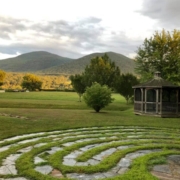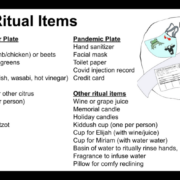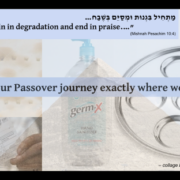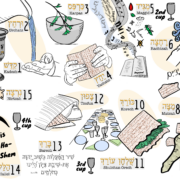Though winter has not yet lessened its grip, we know that under the snow and ice, early flowers are popping up and foreshadowing spring.
This year April overlaps, more or less, with the lunar month of Nissan. At the full moon of Nissan we retell our people’s core story as we celebrate Pesach, festival of our liberation.
As it says in the traditional haggadah:
We were slaves to a Pharaoh in Egypt, and the Holy One brought us forth from there with a mighty hand and an outstretched arm… Therefore it is incumbent on each of us to see ourselves as though we, ourselves, had been brought forth from Mitzrayim.
Dear all,
I’m looking so forward to celebrating with you at our Second Night Community (Zoom) Seder. Like last year, our seder will be co-facilitated by me and by R. David Markus, and we’ll share it with Temple Beth El of City Island, the community with which some of us journeyed to Cuba before the pandemic began.
During the pandemic I know it isn’t always easy to find the groceries we’re looking for. If you don’t have or can’t find these items, never fear: we will make it work and seder will be beautiful even without these things! But if you can find these things and have them on hand, they will help make the night more special and more real.

Please remember to RSVP by Wednesday to the synagogue office so we know you’re coming. (The Zoom link will not be the one we use for services, and it will not be posted anywhere, in order to prevent zoom-bombing.)
See you at Seder!
Blessings to all,
Rabbi Rachel
A slide from Bayit’s Pesach offerings this year.
Many of you have heard me say that on Shabbat HaGadol, the Shabbat before Pesach, it’s customary for the rabbi to give a sermon about how to prepare for Pesach. Traditionally speaking, I’m supposed to give you instructions on how to prepare yourselves and your homes for Passover. You know — here are the five “leavenable” grains, here’s how to remove them from your homes for a week, here’s the halakha on how to properly clean to remove every last scrap of hametz.
As we approach our second pandemic Pesach, the idea of preparing for Pesach feels different than it ever has before. I mean, if you remove hametz, you can do that the same as you always have. And even if you’ve never followed that tradition, you can mark the week by making a conscious choice not to eat bread. A week of mindful eating is a valuable experience and a deep way to connect with our traditions. But that’s not the kind of preparation with which I’m grappling this year.
It’s the inner preparation that’s challenging me. Because the pandemic continues. Last year who could’ve imagined that we’d be here now: preparing for another Zoom community second night seder? Still staying apart to protect each other and ourselves. Many of us still in lockdown mode, or sheltering in place, to prevent the spread of a virus that’s still killing 1200 people each day in this country — about three times as many as last July 4; the equivalent of a 9/11 every three days.
There are three excellent vaccines out in the world now. There is reason to hope that once the population reaches a certain vaccination threshold, we will be able to be together safely again. Elementary schools are even about to re-open! But we are not “there yet.” What does it mean to prepare ourselves for liberation when many of us may still feel constrained: by pandemic, by economic challenges, by racism and all the harm it creates, by the reality of anti-maskers and anti-vaxxers?
The haggadah teaches: in every generation one must see oneself as if one had been liberated from Mitzrayim / the Narrow Place — from tzuris / suffering, from meitzarim / constrictions. How can we see ourselves as if we were going forth from those tight spaces when we are still manifestly living in them? We aren’t liberated from COVID. We aren’t liberated from racism and hatred. We will celebrate Pesach as a community again via digital means, not “in person.” What kind of liberation can this be?
Earlier this winter I worked with a group of poets, artists, rabbis, and liturgists to co-create new materials for the start of seder, recognizing the meitzarim that still bind us so that we can prepare our spirits for the liberation that is not yet quite here. (We’ll use those materials at our community seder on Zoom with Rabbi David and the TBE community — please sign up now, we need your RSVP by Wednesday!) And, there are things we can do practically to prepare our hearts to go free.
Set your seder table with a white tablecloth, if you have one. If not, use a bedsheet… or whatever festive cloth you can find. Make it feel different than on a regular night. It’s too early to have spring flowers where we live, but if you can pick up a bouquet at the grocery store, treat yourself: a symbol of spring, something beautiful and festive. Put candles on your festival table: we’ll light them to bring the light of the festival into the room and into our hearts.
Create a second seder plate memorializing this COVID year: hand sanitizer, a face mask, a vaccination card if you’re fortunate enough to have had a shot. We’ll light a memorial candle for the half a million who have died as we move through the door into this year’s community seder. And you’ll also want a “regular” seder plate symbolizing our ancestral story of freedom: an egg, a roasted shankbone or beet, a sprig of green, haroset, maror. Maybe an orange and an olive.
We’ll harness our sensory experiences to bring us into the festival of freedom. The crunch of matzah, the taste of parsley (or whatever you use for karpas, the green vegetable dipped in salt water tears), the sharpness of horseradish and sweetness of haroset… all of these will spiritually hyperlink us with seders past and seders to come. Our people have celebrated Pesach in narrow straits before. Our rituals give us strength, and they connect us with each other and with our Source.
The journey to Passover begins where we are. Not in some imagined reality where the pandemic never happened, but right here and now. And I know with all my heart that when we gather on Zoom for second night seder, the words and the tastes and the rituals will lift us out of where we are and prepare us for the unfolding of something new. The journey to Sinai. The journey to togetherness. The journey to the better world we’ll build together on the far side of the sea.
This is the d’varling that Rabbi Rachel offered at Kabbalat Shabbat services (cross-posted to Velveeteen Rabbi)
Dear CBI Community,
Pesach is coming soon. In this email you’ll find resources for holding a first-night seder at home, information about a second-night Zoom seder, and a ritual for ending Pesach, too.
Second Things First: Our Second Night Seder
Although we’re not holding a second night community seder in person at CBI this year, we are planning to offer a Zoom-based Second Night Seder.
Please RSVP to me (rabbibarenblat at gmail dot com) and let me know if you will join us at via Zoom at 6pm on Thursday April 9. I’m working now on figuring out exactly how that seder will work, and to some extent the answer will depend on how many of us are coming and how many of us are kids. Thank you!
Getting Ready
It may be hard to imagine a seder during sheltering-in-place or quarantine. But the Passover seder is a home-based ritual that can be meaningful even when one is homebound. Even the possibility of a solitary seder isn’t new: Talmud teaches that if one is alone at Pesach, one should ask the Four Questions of oneself. Whatever we do this year won’t be “the same” as the kind of seder most of us are used to, but nothing about this year is the same as usual. Maybe the very strangeness of this year’s seder can help us experience the spiritual dynamics of the Pesach journey in a new way. Here are some tools for building this year’s seder:
Building Blocks of the Seder
The core mitzvot of seder are:
- bless juice or wine (and drink four cups, or sips, thereof)
- recount the story of the Exodus in some form
- bless and eat matzah
- assemble a seder plate, and explain its elements
- eat a celebratory meal
- read or sing words of praise (traditional psalms – or contemporary poetry?)
- eat a bite of afikoman (ceremonial matzah to end the meal)
- recline / reflect on freedom
You don’t need a fancy seder plate if you don’t have one on hand; a regular plate is just fine. Here’s a list from the URJ of What Items Go On the Seder Plate. Some also add an orange (representing the inclusion of all genders and sexualities), an olive (representing hopes for peace), a tomato (representing migrant/farm worker safety), and/or other meaningful items.
Blueprints For Your Seder
If you don’t have haggadot at home, here are some free downloadable haggadah options. It’s a good idea to download a haggadah in advance and spend some time with it so you can move through it comfortably when seder time arrives.
- Haggadah Sketchnote from Steve Silbert – A one-page haggadah! You can also purchase a higher-resolution print (among many other things) at the Visual Torah Redbubble store.
- Velveteen Rabbi’s Haggadah for Pesach – This haggadah created by R’ Rachel Barenblat features classical texts alongside contemporary poetry and illustrations.
- If you’re drawn to a social justice/ tikkun olam lens, T’ruah offers The Other Side of the River, The Other Side of the Sea: A Human Rights Haggadah and American Jewish World Service offers Next Year in a Just World.
- Make Your Own Passover Haggadah at Haggadot.com.
Of course, the haggadah is only a roadmap. Your internal spiritual journey will be shaped by you.
A Ritual to Close the Week, Too
Here’s a resource for celebrating a different kind of seder on the seventh day of the holiday (rather than the first or second): Seder for the Seventh Night by Rabbi Evan J. Krame
If you experiment with a seventh night seder, I hope it will help you feel that you’ve “come through the sea” and are able to sing out in praise on the other side.
Not Like Other Nights
This year is not like any other year. Whatever seder is for each of us this year, it will probably not be what we’re accustomed to. We trust that the ritual will still hold meaning, even though (r maybe especially because) we’re experiencing it in an unprecedented way. What does it mean to recount the tenth plague in a time of quarantine? What does it mean to seek to experience spiritual liberation at a time when many of us may feel “bound” by anxiety or illness or circumstance? What does it mean to celebrate Pesach meaningfully if we are home alone? I look forward to hearing your answers to these questions as the holiday unfolds this year.
Blessings to all,
Rabbi Rachel
These resources for Pesach during a time of quarantine also appear at Builders Blog, a project of Bayit: Building Jewish.

